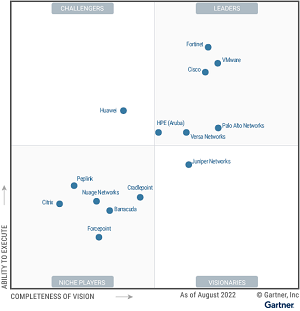News
Research: SD-WAN Moving to Security Offerings, Getting AI Boost
Research firm Gartner's new report on the software-defined wide-area networking (SD-WAN) space sees the tech moving into security offerings and receiving a big generative AI boost in the next few years.
The latter, of course, can be said of just about any IT products and services these days, but Gartner sees an especially significant AI assist coming for SD-WAN, as it's starting from basically nothing this year.
"By 2026, generative AI technology embedded in SD-WAN offerings will be used for 20 percent of initial network configuration, up from near zero in 2023," the firm said in the "Magic Quadrant for SD-WAN" report published last week.
The firm sees the AI infusion into SD-WAN as part of a larger trend affecting networking overall, as discussed in a May article titled, "Innovation Insight: AI Networking Has the Potential to Revolutionize Network Operations."
"There is a trend toward more autonomous and self-driving networks in which AI/ML technologies can be leveraged to make networking decisions without or with limited human intervention," Gartner said last week. "While much of this is aspirational today, the objective is to make networking easier for design and configuration/deployment, with simplified ongoing management to reduce operating expenditures (opex), increase speed/agility and improve uptime/performance. Although it is still early in many vendors’ product development, we are seeing this functionality incorporated into an increasing number of vendor solutions offering differentiation. The longer-term challenge will be customer trust in using such solutions."
The SD-WAN space has seen significant growth over the past few years as it continues to replace traditional branch routers and enable connectivity among enterprise branch locations and to the cloud, with the report explaining: "SD-WAN products provide dynamic path selection, based on business or application policy, routing, centralized orchestration of policy and management of appliances, virtual private network (VPN) and zero-touch configuration. SD-WAN products are WAN transport/carrier-agnostic and create secure paths across physical WAN connections.".
Another "strategic assumption" about SD-WAN in the report states: "By 2026, 60 percent of new SD-WAN purchases will be part of a single-vendor secure access service edge (SASE) offering, up from 15 percent in 2022." This reflects yet another convergence: SD-WAN with Security Service Edge (SSE), the latter being a term coined by Gartner for security component of the Secure Access Service Edge (SASE) security framework.
"Enterprise SASE adoption is currently dominated by multivendor solutions (one vendor for networking and one for security), with some type of orchestration tying it together," Gartner said. "Over time, we expect to see more single-vendor, integrated SASE solutions incorporating the SSE and SD-WAN branch components."
As far as "Leaders" in SD-WAN, the 2023 report shows the same cast of characters as the 2022 report.
 [Click on image for larger view.] 2023 Magic Quadrant for SD-WAN (source: Gartner).
[Click on image for larger view.] 2023 Magic Quadrant for SD-WAN (source: Gartner).
 [Click on image for larger view.] 2022 Magic Quadrant for SD-WAN (source: Gartner).
[Click on image for larger view.] 2022 Magic Quadrant for SD-WAN (source: Gartner).
Market recommendations for infrastructure and operations (I&O) leaders responsible for building and managing WANs listed by Gartner include:
- Build a WAN architecture that aligns with end users, branches and applications. This may mean a hybrid WAN with MPLS and internet, or internet only with dual internet. This depends on how many on-premises workloads versus cloud workloads exist, the types of applications, the number of users at a site and the locations of end users.
- Cloud-first organizations that heavily utilize public cloud and SaaS services should determine SD-WAN offering suitability by validating depth and/or breadth of cloud provider and cloud onramp integrations.
- When implementing a dual-vendor SASE architecture, lean toward SD-WAN/SSE combinations with deep explicit integration by performing a POC and focusing on the GUI integration as well as automatic traffic redirection.
- Operationally focused organizations should evaluate SD-WAN vendors by analyzing network automation and AI networking capabilities as a core requirement to improve support efficiency.
- Choose SD-WAN vendors to optimize application performance by evaluating performance optimization capabilities for real-time and non-real-time traffic, whether the applications are delivered on-premises or from the cloud.
- Shortlist at least two SD-WAN product vendors, whether for a new deployment or large renewal/refresh.
- Quantify the total cost of hardware, software and maintenance for an SD-WAN deployment. SD-WAN solutions more commonly have opex-friendly business models, with a strong shift from upfront capex to annual license subscriptions. To perform a proper evaluation and comparison, quotes should include all platform, license and support costs over a three-year baseline.
- Prefer SD-branch solutions to simplify the management of LAN, WLAN, SD-WAN and security for small branch offices.
- Run a pilot to test the SD-WAN solution in a production capacity to validate performance in a real-world environment. Ensure that at least one critical site is tested with the solution deployed before any final decision is made.
While Gartner usually opens up its research only to clients, Magic Quadrant reports are typically available from covered vendors in licensed-for-distribution editions that can be found with a quick web search.
About the Author
David Ramel is an editor and writer at Converge 360.